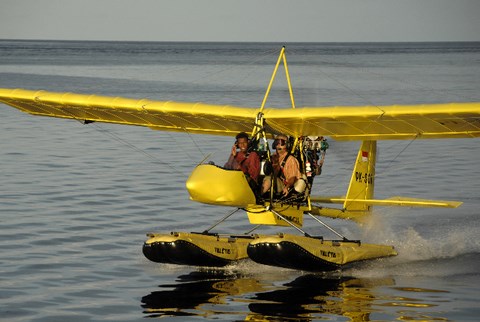Full Lotus bladders

Full Lotus Bladders - When flying on Full Lotus floats there are a number of things that you should have near by.
- Pressure gauge for checking air pressure in each bladder of the float prior to each flight
- Air pig or pump for refilling bladders
- Spare bladders for both front and rear of float
- Make sure to fly with a bladder repair kit in your tool kit.
It is important the Full Lotus float system be checked for proper inflation before each flight.
- Under inflation of the bladders can cause the bladder to move inside the float, which will eventually cause it to leak.
- Over inflation can lead to a bladder exploding on landing causing loss of floatation.
Bladders should also be removed several times a season and checked for water. The bladders will collect water from osmosis, and condensation. Several pilot have reported accumulations of over a gallon of water in their bladders!
Remember this water is able to MOVE. During lift off it will move to the REAR of the float. This can cause loss of control due to improper C of G. Unlike regular floats which can be pumped out the only way of removing the water the Full Lotus system is to remove the bladders. I have measured over 10 gallons of water in a set of floats during a training session in Northern Ontario!
One pilot flying his craft on floats in winter reported over 40 lbs of water had frozen into ice in the rear of his floats!
Full Lotus Zippers - Several years ago Full Lotus updated the way that the top and bottom sections of their floats were held together. The older system used plastic zippers to join the two halves together.
There were apparently reports of failure of this system.
In November of 1998 Full Lotus issued a "CEASE FLYING" directive for their float system. It basically said to stop flying on the float until a FREE at the time update was installed.
Full Lotus Float Updates
Step Area - The step area of the Full Lotus float has been modified several times.
- The first modification replaced the wood material used at the step for support with metal. It was found that the wood rotted with time and exposure to water.
- The second modification was the addition of a set of small bladders located in the step area of the float. Pilot's of heavier ultralight aircraft with double surfaced wings were reporting problems getting airborne.
The problem was traced to the float support tubes bending when the pilot rotated for lift off. This allowed the front of the float to move up but kept the back of the float on the water preventing lift off.
The bladder system stiffens up the float in the middle. Experience has shown that while this helps, it also suggested that thicker walled tubing be used for float support. The recommended tubing even with sleeves is just not rigid enough when used on heavier ultralight aircraft requiring 40 to 50 mph to lift off.
Full Lotus bladders problem
Full Lotus Floats have 16 bladders in them. We took apart the 1260 full-lotus floats and and drained out over 1 quart of water out of each bag.
We got about 4 1/2 gallons of water or over 40 lbs out of these. We installed these floats new about 2 years ago and that is what accumulated in them since.
So Full lotus float users, check your floats before your next flight. Ultralight, homebuilt amateurbuilt.
This movie posted at rotaxaircraft DOT com forum This would make a good article on UPAC ,RAA or


